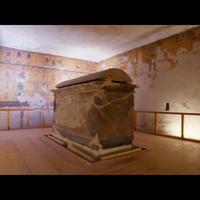Tutankhamun's True Burial Chamber | Lost Treasures of Egypt
[dramatic music playing]
It's always exciting.
Sometimes there is even between the workmen
a bit of a competition.
Who will find first?
NARRATOR: While conservators move the painted walls
to the store rooms for safekeeping,
Tarek spots something in the sand.
We have a pillar.
And I can see already there is a djed pillar decorated on it.
NARRATOR: It's an important find.
This pillar confirms the nature of ancient Egyptian religious
beliefs in the years after the Amarna Revolution
and Tutankhamun's death.
This is exciting.
The deceased is appearing now, as he would have
been carrying the djed pillar.
NARRATOR: The djeds symbol represents the god Osiris,
who arose from the dead to live again as king of the afterlife.
Ancient Egyptians painted the symbol on the bottom of coffins
and wrapped the mummy with djed amulets
to summon Osiris and rejuvenate the soul of the deceased.
They also carved djed symbols onto the pillars in their tombs
to follow Osiris to the afterlife.
[mysterious music playing]
In the time of Amarna, they told them
that there is no afterlife.
After, there was a reaction to an extreme, worshipping Osiris.
NARRATOR: The team has found inscriptions
to Osiris and Ptah, gods whose worship Tutankhamun's
father had forbidden.
It's more evidence Tutankhamun had abandoned
his father's revolution.
He had restored belief in the afterlife
and the power of all Egypt's gods.
The religious revolution demanding the worship
of a single sun God was over.
This was a feat that deserved a magnificent burial
and a majestic tomb.
So why didn't Tutankhamun's mummy get the tomb it deserved?
In the Valley of the Kings, Aliyah
is investigating this mystery.
Why does Ay banish Tutankhamun to such a small
and poorly decorated tomb?
Aliyah examines Ay's tomb to look for clues.
That's the baboon wall.
Both Tut and Ay opted for the same scene,
almost like the same person chose what goes in each tomb.
NARRATOR: The uncanny similarities
between the two chambers suggests a common hand
was at work on both.
But only Ay's tomb was fit for a pharaoh.
It's very similar to the tomb of Tutankhamun-- the style,
the artwork, the sarcophagus.
But it's so much bigger.
NARRATOR: The artistic style of the two tombs
suggests that Ay may have been responsible for decorating
both.
Investigators now suspect that when Tutankhamun died
unexpectedly young, the lavish tomb he ordered for himself
was not finished.
Ay seized the moment.
He ordered Tut be buried in a smaller tomb.
It was quickly decorated and sealed before the paint
had a chance to dry.
With Tutankhamun gone, and before any challengers could
oppose him, Ay crowned himself pharaoh
and decreed that when he died, he
would take Tutankhamun's tomb.
[dramatic music playing]
Ay buried Tutankhamun in the smaller tomb,
so he could have the bigger tomb for himself.
This is the tomb that was intended
for Tutankhamun, the tomb of Ay
NARRATOR: Ay banished Tutankhamun to an unworthy tomb
to secure his place as pharaoh.
Later pharaohs erased Tutankhamun
from history, smearing his name as the son of a heretic.
But 100 years ago, when his tomb was discovered,
Tutankhamun was reborn a superstar.
Now experts use the clues to piece together his true legacy
as a boy king dealing with the aftermath of his father's
religious revolution.
[music playing]

